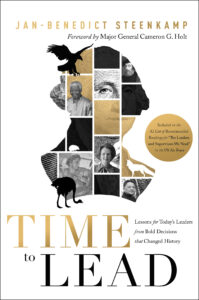It’s Time to Lead
Where is leadership when we need it?
What can today’s corporate, non-profit, military, and public-service leaders learn from daring decisions that changed history?
In sixteen historical studies, Jan-Benedict Steenkamp reveals lessons for today’s leaders from decisions that changed history. After reading Time to Lead: Lessons for Today’s Leaders from Bold Decisions that Changed History, I reached out to Jan-Benedict Steenkamp to share more about his research. Each of his lessons presents a fresh examination of history-making leaders by holding a magnifying glass up to a life-changing dilemma each of them faced. What we learn is how powerful the personalities of leaders and their decision-making processes can be in determining the course of human events—and the fates of millions of people.
After studying, researching, and writing so much on leadership, what is your definition?
Leadership is “the ability of an individual to influence others to achieve a common goal.” This definition contains five components. First, leadership is relational. It exists only in relation to followers. Second, leadership involves influence. Without influence, leadership does not exist. Third, leadership is a process. Leadership usually does not happen in just one particular instance, but often involves a complex system of moves/actions to accomplish a goal over a period of time. Fourth, leadership includes attention to common goals. Leaders direct their energies toward others to achieve something together. This requires awareness of the current state, some vision of a desired future, and an ability to move from where you are to where you want to be. Finally, leadership is about coping with change. The common goals are often different from what the organization has done hitherto.
I’d love your take on why studying leadership is critically important.
Leadership has been a feature of mankind since its early beginnings, when as hunters we needed coordination to overpower much stronger animals. Coordination required leadership. And, as human complexity increased, the number of leaders, and the complexity of the demands placed upon them, increased. Today’s society would come to a standstill without leadership. Indeed, leadership is one of the key issues of our times. Countless people occupy leadership positions, whether in government, companies, churches, nongovernmental organizations, schools, nonprofit organizations, or elsewhere. More change always requires more leadership and today, we are experiencing unprecedented change and challenges. According to a Wall Street Journal/NBC News poll, 80% of Americans feel the country is out of control.
What are some of the traits of a leader that consistently appear in every generation?
 The 16 case studies discussed in my book reveal a remarkable variation in the personal qualities of the leaders, all of whom were effective in changing history. Some leaders were highly intelligent (e.g., Alexander the Great), others not particularly so (e.g., Campbell-Bannerman). Some had exemplary integrity (Mandela), others decidedly not (Clovis). Some excelled in humility (St. Peter), others not at all (de Gaulle). Some were highly educated (King), others received little formal education (Washington). Some were very sociable and good at building relations (Roosevelt), others not so much (Nightingale).
The 16 case studies discussed in my book reveal a remarkable variation in the personal qualities of the leaders, all of whom were effective in changing history. Some leaders were highly intelligent (e.g., Alexander the Great), others not particularly so (e.g., Campbell-Bannerman). Some had exemplary integrity (Mandela), others decidedly not (Clovis). Some excelled in humility (St. Peter), others not at all (de Gaulle). Some were highly educated (King), others received little formal education (Washington). Some were very sociable and good at building relations (Roosevelt), others not so much (Nightingale).
However, all these leaders had one thing in common: grit. Grit is the courage and determination that makes it possible for somebody to continue doing something difficult or unpleasant. Gritty leaders have focus, self-confidence, motivation to succeed (overcoming obstacles, persistence), and resilience (rebounding from setbacks, weathering criticism, performing under pressure). Grit is the common denominator that ties together the lives of Themistocles and Thatcher, of King Clovis and Martin Luther King. Time to Lead contains a grit scale that allows you to determine how gritty you are, with recommendations of what to do next.
You use Isaiah Berlin’s hedgehog and the fox reference but add in the eagle and ostrich. How does this framework shape your understanding of leaders?
Using this framework allowed me to more deeply understand how leaders are successful. I draw out five lessons:
- All leaders in my book had an overarching goal that guided their lives—that is, they all possessed hedgehog qualities—even if that overarching goal was sometimes formulated only late(r) in their lives.
- Most of the leaders in my book combined the qualities of the hedgehog and fox—they were eagles. Eagles have a farsighted vision—which they combine with great tactical agility. They excel in aligning potentially unlimited ambitions with necessarily limited organizational capabilities. Eagles know where they are going (ends) and how to get there (means). They can deal with immediate priorities yet never lose sight of long-term goals. They may seek to increase their means before embarking on their journey. Alternatively, they stretch their goals over time, attempting to reach certain goals in the short term, put off others until later, and regard still others as unattainable.
- Over time, there is the danger that a soaring eagle morphs into a hedgehog. Several case studies in my book—one example being British Prime Minister Margaret Thatcher—were strong-willed eagles who over time became so convinced of being right that they lost the tactical flexibility of the fox. As they became more rigid, people grew tired of them.
- Many managers are foxes, more focused on tactical short-term decisions than on achieving strategic long-run goals.
- Ostriches lack a compelling, overarching central vision. If they pursue ends at all, they are unrelated and even contradictory, and they fail to accurately assess the means at their disposal or to link means with ends. You will find them in most organizations, but they are disproportionately present in large, bureaucratic organizations with high job security and an emphasis on “going with the flow.” Being an ostrich is not conducive to becoming an effective leader. If you are one, you can take steps to improve your leadership as several leaders discussed in my book actually started out as ostriches.
What are you? You can do the test by clicking on the button “Quiz” on the website here.
You share numerous historical examples of leaders within that framework. As someone who loves history and leadership, I appreciated your approach and found the insights incredibly helpful. Of all the people you featured, who stands out for you and why?
One leader who stands out in this august group is President Franklin D. Roosevelt. He faced trials that exceed even our current challenges—the Great Depression and World War II. How he responded to these crises holds lessons for us today.
- In crises, people want their leader to lead, not to follow. In his famous “First 100 Days,” FDR pushed through 15 major pieces of legislation to get the country back on track. This and other legislation sent a clear signal to the people that Washington was ahead, not behind, the curve.
- In a crisis, people want their leaders to be rational, cool, measured, and consistent. How many of us trust a leader who is erratic, given to emotional outbursts, and focused on themselves rather than on us? FDR was composed under almost all circumstances. One of the most famous examples is how FDR started his Inaugural Address of March 4, 1933. His words resonate thorough time: “So, first of all, let me assert my firm belief that the only thing we have to fear is…fear itself — nameless, unreasoning, unjustified terror.” When people heard these words, confidence soared.
- People intuitively understand that in crises, together as a nation, they can accomplish things that no individual or group can achieve on their own. This requires that the leader unifies the people and makes them part of the conversation. FDR frequently used phrases like, “Let us sit down together again, you and I, to consider our own pressing problems that confront us.” For him, there was no “us” and “them,” only “we.”
- The way he got Americans to follow his lead and help Britain in 1940-1941 when the country was overwhelmingly isolationist is a textbook example of persuasive leadership, which I have used time and again in executive audiences.
FDR’s leadership has also personal relevance to me. My parents lived in Nazi-occupied Amsterdam (the Netherlands) during World War II, praying every day to be liberated. When I was writing the chapter on FDR, I re-read a biography on him given by my late father in 1985, when he was President of the Netherlands’ Senate. This is what he wrote on the first page as a message to me: “Never forget what FDR has done for the liberation of the Netherlands.”
I speak and write a great deal on servant leadership, so I enjoyed that section in particular. What is it about this style of leadership that is making it so relevant today?
Servant leaders put followers’ interests above their own self-interest. That resonates with people today because it is so different from what many leaders do right now. As we are experiencing this economic crisis, millions of Americans are furloughed or laid off, while at the same time, we read almost every day that CEOs get special bonuses and handouts. Here is an example, reported by the Wall Street Journal. According to the Journal, 40% of Sonic Automotive workers were laid off/furloughed in the spring of 2020. Its CEO David Smith gave up 97,000 restricted shares awarded on Feb. 12, when the stock closed at $32. This sounds good. Unfortunately not! Instead, on April 10, he received options on 457,000 shares with the stock at $16.76. On October 2, the stock closed at $43.44. This is not an isolated example. With growing income inequality and increased poverty, people are thirsting for leaders who serve others rather than themselves.
There are many…thus the book…but if you had to choose just one leadership lesson from the past to impart to the next generation, what would it be and why?
Do not try to adopt a leadership style that does not work for you, given your personality, values, and character. For example, Margaret Thatcher could not have been a servant leader, even if she would have tried it, because it is not her. Many people are simply not charismatic, others do not have the mindset to be a disruptive leader, and so on. But the good news is that is OK. There is not a single universally effective leadership style, whatever gurus may claim. As I show in my book, vastly different leadership styles can be effective. The “only” two things that consistently help to maximize your effectiveness as leader over time are grit and having an overarching goal that guides you in your career.
To help you understand your leadership style, Time to Lead contains a self-assessment instrument with recommendations on how to use your personalized results.
Boost Your Positive Intake
For more information, see Time to Lead: Lessons for Today’s Leaders from Bold Decisions that Changed History.


